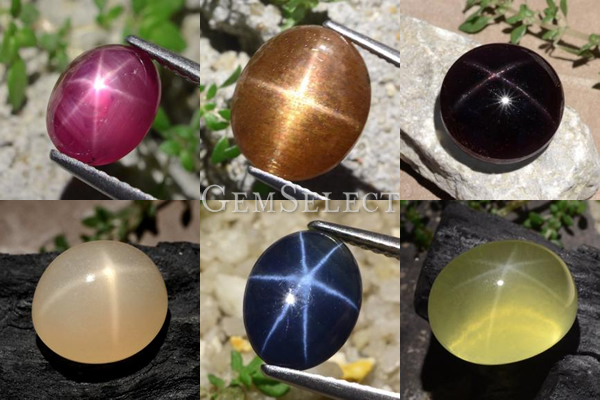|
Reviewed By Andreas Zabczyk
Seeing Gemstone StarsGemstones that display the star effect, known as asterism, have been valued by connoisseurs for centuries. The best-known examples are star sapphire and star ruby. Asterism may also be found occasionally in a number of other gems, including moonstone, quartz, spinel, citrine, diopside, emerald, garnet, chrysoberyl and sunstone.  Natural Star Gemstones
First-time buyers of these star gems sometimes have unrealistic expectations about how sharp and clear the star should appear. Many people have seen synthetic star gemstones with very sharp stars that display perfectly under any kind of light. But this is not the standard by which natural star gems should be judged. To fully appreciate the marvel of a natural star gemstone, it is worth understanding how stars form in natural gems, and how best to observe the asterism. The essential element in producing a star gemstone is the mineral rutile. If inclusions of rutile are densely packed, and aligned in the correct way, then they will reflect light in a multi-rayed pattern, forming a star. The gem must be cut as a cabochon in order to display a star, and it must have the right proportions; neither too flat on the top nor too heavy on the bottom. Star gemstones tend to be opaque or translucent rather than transparent, due to the rutile inclusions. This often affects the color of the gem. In fact, there is a trade-off between the distinctness of the star and the saturation of the body color. More rutile means a more distinct star, but a somewhat muddier color. Since color is also very important in these star gems, cutters try to strike a balance between the star and the body color when selecting their material.
Most natural star gems display a star only in sunlight or in strong indoor light. Even very good quality stars show poorly in diffused light. A focused light displays the star best, and all photos you see of these stones will be taken under such lighting. Gem dealers use a penlight to evaluate star gems. The trick is to hold the light about 15 cm (6 inches) above the stone. Move the light back and forth to see how the star moves across the surface of the stone. The star should be sharp and clear, and the rays should be straight and evenly spread. The star should be centered at the top of the dome, and it should extend across the entire stone. It should travel easily across the surface of the cabochon as you move the light back and forth. Some natural star sapphires are enhanced by a process that diffuses rutile into the gem to improve the star. The treatment is permanent and produces good results. Most star rubies are not diffusion-treated to improve the star, but some are fracture-filled. This Page in Other Languages
|
| STAY IN TOUCH | NEWSLETTER |
| *You're signing up to receive GemSelect promotional email. |
Copyright © 2005-2024 GemSelect.com all rights reserved.
Reproduction (text or graphics) without the express written consent of GemSelect.com (SETT Company Ltd.) is strictly prohibited.
646